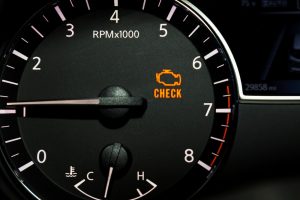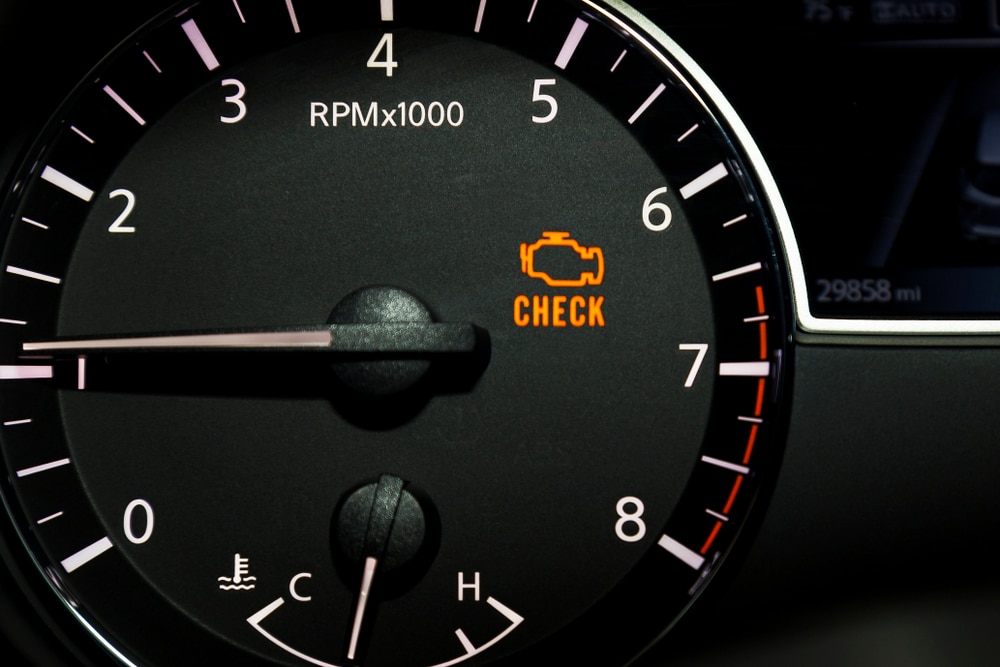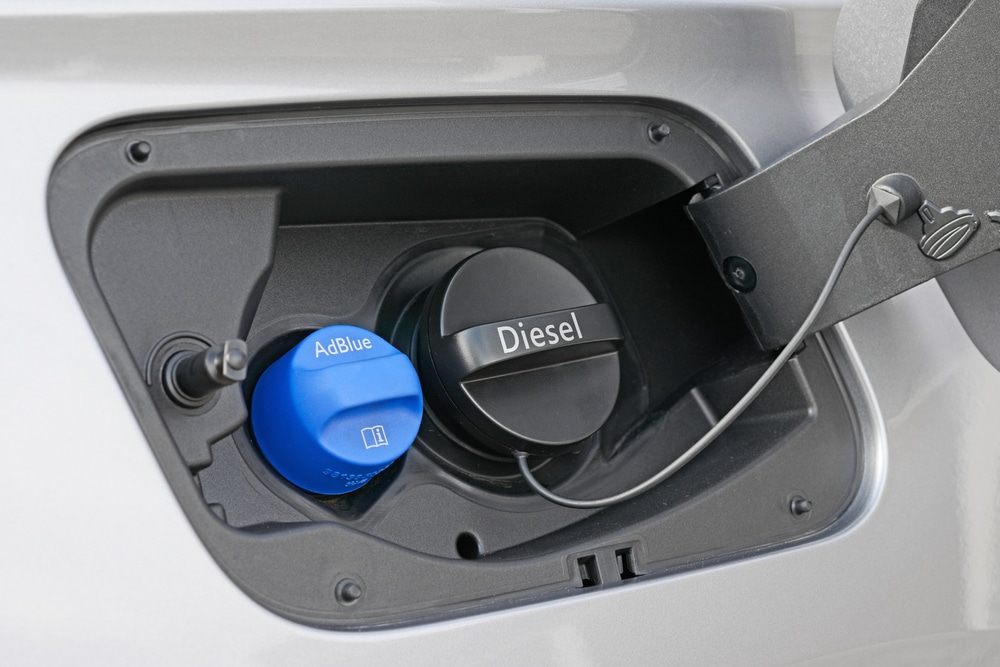Mercedes Check Engine Light
When driving your Mercedes, one of the last things you want to see is the dreaded check engine light.
Sadly it can happen occasionally and it’s not something you want to ignore.
This signal is a vital warning that your vehicle could have an issue. Taking action promptly ensures your car operates efficiently, prolongs its durability and reduces the expense of repairs.
Comprehending the significance of the check engine light and the steps for accurately identifying its trigger can spare you time and keep your vehicle in top shape.
In this complete guide, we’ll help you understand this crucial alert, aiding you in making well-informed choices regarding the upkeep of your Mercedes.

Understanding the Check Engine Light
The check engine indicator on your Mercedes is a crucial alert for various possible problems, from simple fixes such as a required oil change to significant issues like exhaust failures.
It’s part of your car’s onboard diagnostics (OBD) system, which notifies you when it’s time for service or an inspection.
Your Mercedes uses the check engine light to help differentiate the severity of issues: a continuous light often means a less critical problem whereas a blinking light warns of a more severe condition that requires immediate attention.
While some vehicles use colour codes to show the severity of a fault, Mercedes doesn’t.
Common Reasons for the Check Engine Light
The check engine light in a Mercedes can illuminate for various reasons, including:
- Emission Control System Malfunctions: Issues with your vehicle’s catalytic converter or the exhaust gas recirculation (EGR) valve are common culprits.
- Oxygen Sensor Failure can lead to reduced engine efficiency and higher emissions. You should address this immediately.
- Mass Airflow Sensor (MAF) Problems: A malfunctioning MAF sensor can negatively affect your Mercedes fuel economy by inaccurately measuring air intake, increasing fuel consumption.
- Spark Plug Or Ignition Coil Defects: These issues can significantly reduce engine performance and even lead to engine misfires.
- Loose Or Damaged Gas Cap: A compromised gas cap can cause fuel vapour leaks, negatively affecting your vehicle’s emissions and fuel economy.
When it comes to your Mercedes, certain models or years may be more susceptible to specific problems.
For instance, C-Class vehicles from the early 2000s frequently encountered MAF sensor failures. While E-Class models from the late 2000s were more likely to have EGR valve malfunctions.
Knowing of these model-specific flaws can streamline the troubleshooting process, allowing you to diagnose the issue faster.
On-board Diagnostics (OBD) System Overview
Your Mercedes is outfitted with an advanced Onboard Diagnostic (OBD) system tasked with monitoring crucial performance metrics such as:
- Engine speed
- Fuel mixture
- Ignition timing
This system is engineered to detect, log and notify you of any malfunctions your Mercedes engine or key operational systems are having.
Whenever the OBD system encounters a problem it can’t solve, it records a Diagnostic Trouble Code (DTC). This activates your dashboard’s check engine light as a signal to you.
To figure out the exact nature of the fault indicated by your Mercedes check engine light, an OBD-2 scanner can be connected to the OBD-II port, typically found beneath the dashboard. This device reads the stored DTCs, allowing the root cause of the issue to be found.
If diagnosing or resolving the issue yourself seems daunting, we recommend seeking help from our experts at Quality Car Service. Our team, with extensive experience with Mercedes vehicles, is dedicated to providing the care and expertise your car deserves.
Checking for Loose Fuel Cap
A loose or damaged fuel cap is a frequent culprit behind the dreaded Mercedes check engine light, as it can cause alterations in your vehicle’s fuel system pressure.
Your Mercedes Onboard Diagnostic (OBD) system may interpret these pressure changes as a leak in the emission control system, designed to capture fuel vapours and prevent them from escaping into the atmosphere.
Should you suspect your check engine light is a result of a fuel cap problem, try the following:
- Locate the fuel cap, which is typically behind a fuel door on the side of your vehicle. Rotate the cap counterclockwise to remove it.
- Inspect the cap and the fuel inlet for any signs of damage, wear or debris that could be preventing a tight seal.
- Clean your vehicle’s fuel cap and the inlet area before resecuring it if necessary. To do this, turn the cap clockwise until it clicks.
Be aware that the check engine light may persist for a few driving cycles even after your fuel cap is corrected as the system needs time to confirm that the issue has been fully resolved.
If the light remains on or you’re unsure about the process, Quality Car Service offers professional assistance and support.
Common Diagnostic Trouble Codes and Meanings
Mercedes vehicle owners may encounter various Diagnostic Trouble Codes (DTCs), each alerting them to different issues within their vehicle.
Here are some frequently encountered codes:
- P0300 Series (P0300, P0301, P0302, etc.): These codes are associated with engine misfires. A P0300 code indicates multiple misfires across various cylinders, while codes like P0301, P0302 identify misfires in specific cylinders.
- P0171 and P0174: These codes suggest the engine is running lean, with a mixture containing too much air and insufficient fuel. Causes might include vacuum leaks or problems within the fuel delivery system.
- P0401: This code points to issues with the Exhaust Gas Recirculation (EGR) system, which helps lower nitrogen oxide emissions by recirculating your vehicle’s exhaust gases back into your vehicle’s engine cylinders.
- P0420 and P0430: These codes indicate inefficiencies in the catalytic converter for bank 1 (P0420) or bank 2 (P0430), potentially affecting your Mercedes emissions control and vehicle performance.
Grasping the implications of these codes is crucial if you want to solve your Mercedes problems fast.
However, if you’re not comfortable diagnosing or interpreting these DTCs, our Mercedes specialists at Quality Car Service can help. Call us today for an expert checkup.
Looking for Air Intake and Vacuum Leaks
When your Mercedes check engine light appears on your dashboard, it might alert you to complications with the air intake system or vacuum leaks which can disrupt the optimal air-fuel balance needed for efficient engine operation.
Signs of air intake or vacuum leak problems include:
- Unusual hissing sounds from your vehicle’s engine indicate a vacuum leak.
- An increase in fuel consumption as the engine adjusts for a lean mix by adding more fuel.
- Rough idling or difficulty starting the car due to an incorrect air-fuel ratio.
Addressing these issues swiftly can keep further engine damage at bay, saving time and money. The last thing you want to do is ignore the problem and for it to worsen. It could cost you a fortune.
Contact Quality Car Service for a quality check-up at better than dealership value.
Exhaust System and Emissions Issues
Your Mercedes exhaust system plays a pivotal role in managing vehicle emissions. Issues such as a defective catalytic converter or exhaust manifold leaks can light up your check engine light. These problems can hamper your car’s ability to efficiently process and remove exhaust gases, increasing your vehicle’s emissions and reducing overall performance.
If you want to keep your emissions control system in peak condition, consider the following steps:
- Regular inspections of your exhaust system for physical damage or leaks.
- Evaluating and replacing the catalytic converter if necessary.
- Monitoring oxygen sensors, which are crucial for assessing combustion efficiency and the catalytic converter’s effectiveness.
Routine maintenance is key to avoiding check engine alerts related to the exhaust system or emissions controls.
Engine Sensors and Components
Another reason your Mercedes check engine light may appear is malfunctioning sensors or failing engine components.
These sensors are vital for tracking vehicle performance and overall operational efficiency.
Sensor failures or inaccurate readings can prompt your onboard computer to issue a warning via the check engine light.
Key sensors to keep an eye on include:
- The Oxygen Sensor – Crucial for optimising the air-fuel mix based on exhaust gas analysis
- The Mass Airflow Sensor – This measures air entering the engine
- The Throttle Position Sensor – Indicates the throttle’s position
- Engine Coolant Temperature Sensors – Monitors the temperature of the engine coolant
- Camshaft or Crankshaft Position Sensors – Required for engine timing control
If sensor issues are causing your Mercedes to display the check engine light, our experts at Quality Car Service can help.
Can Low Oil and Fluid Levels Cause a Mercedes Check Engine Light?
Yes, low oil levels or insufficient quantities of other essential fluids may activate the check engine light in your Mercedes. These fluids are critical for ensuring the smooth operation of your vehicle.
A deficiency in these fluids can lead to overheating, increased wear and, in extreme cases, engine failure.
Talk about a nightmare. It’s certainly something you want to avoid.
To prevent these problems, we recommend regularly monitoring your brake fluid, oil, coolant and transmission fluid levels. Adhering to the manufacturer’s recommended maintenance timeline is crucial for the timely replenishment or topping up of all necessary fluids.
For guidance specific to your vehicle, always refer to your Mercedes owner’s manual.
Should you need assistance, our experienced Mercedes specialists at Quality Car Service can help.
When to Seek Professional Diagnostic Assistance
Our experts suggest seeking professional diagnostic services for your Mercedes if the check engine light persists or flashes, especially after addressing common issues such as a loose fuel cap.
We recommend consulting a professional team (like ours) if diagnosing your vehicle’s issues is beyond your capabilities, or if your car is showing unusual behaviour such as:
- Making strange noises
- Stalling
- Performing differently
Our Mercedes specialists use their decades of experience and 15-step diagnostic process to solve any issues your vehicle has during the first visit. With us, you save time, money and stress.
Call our team today for a quality first-time fix at better-than-dealership value.
Clearing the Mercedes Check Engine Light
While resetting your Mercedes check engine light yourself is possible after resolving an issue, clearing the light without solving the root cause of the problem can lead to further issues that could prove costly.
Ensure the primary issue has been fully rectified before attempting to reset the light.
To reset your Mercedes check engine light after a repair, you can:
- Connect an OBD-2 scanner to the port under the dashboard
- Follow the scanner’s instructions to erase the stored codes
- Start your car to check if the light disappears and remains off
If your Mercedes check engine light re-appears, your vehicle needs a closer inspection.
Luckily, our Mercedes experts at Quality Car Service can help. Call our team today for all your Mercedes repair needs.
Preventive Maintenance Tips
Preemptive measures to maintain your Mercedes can substantially reduce the chances of encountering the dreaded check engine light.
The best way to keep this warning light at bay is to perform regular maintenance. Here are some standard maintenance practices you can follow:
- Regular oil and filter changes to maintain a clean, well-lubricated engine.
- Monitoring and maintaining all fluid levels to ensure optimal performance and cooling efficiency.
- Prompt replacement of worn components to prevent unexpected failures.
- Routine checks of the electrical system, emissions controls and engine parts to identify and fix potential problems early on.
By following the list of maintenance practices above, you’ll keep your Mercedes in peak condition and the check engine light at bay.
For expert Mercedes servicing, call our team today at Quality Car Service.



